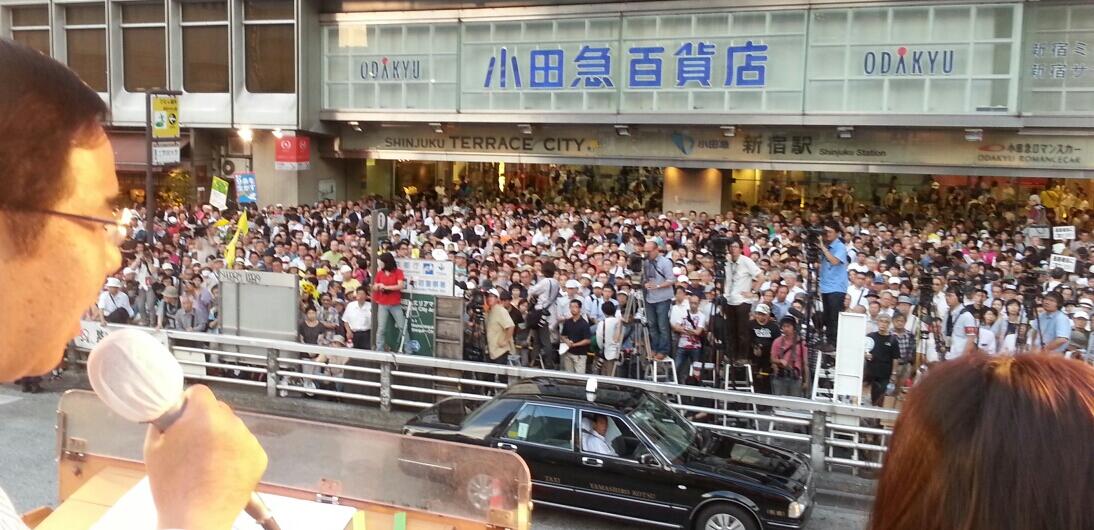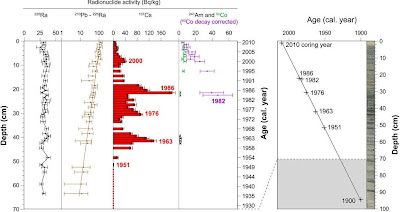(UPDATE at the bottom of the post)
Japanese researchers, including Dr. Makoto Suzuki, who went to Minamisoma City right after the March 11, 2011 disaster and the nuclear accident to help the local OB/GYN doctor Kyohei Takahashi care for pregnant women in the city and help deliver the babies, examined the placentas from 5 women within 50 kilometers from Fukushima I Nuclear Power Plant and 5 women within 290 kilometers from the plant.
Their conclusion is that radioactive cesium concentration in the placentas from 10 women in Fukushima and eastern Japan who gave birth between October 2011 and August 2012 was much lower than in placentas in 1960s during atmospheric nuclear testing, and Italian placentas after the Chernorbyl accident in 1986.
From the abstract below, it is not known how many of the five placentas within 50 kilometers from the plant were from Minamisoma, if any. Much of Minamisoma City was designated by the national government as the area where pregnant women and children were not to supposed to live. But all the government did was to declare so, and there was no support whatsoever to the city or the residents. As the result, there were many pregnant women and children who remained.
Cities like Fukushima, Date, Koriyama, and others in Fukushima's Nakadori (middle third) were never evacuated, even though the levels of contamination turned out to be as much, if not more, than Minamisoma in Hamadori (ocean-third).
From Online Library at Wiley.com, Journal of Obstetrics and Gynaecology Research, Early View published online on July 2, 2013, Abstract:
Radioactive cesium (134Cs and 137Cs) content in human placenta after the Fukushima nuclear power plant accident
Makoto Suzuki 1,
Hiroshi Terada 2,
Nobuya Unno 3,
Ichiro Yamaguchi 2,
Naoki Kunugita 2,
Hisanori Minakami 4,*
1 Department of Obstetrics and Gynecology, Kameda General Hospital, Kamogawa, Chiba
2 Department of Environmental Health, National Institute of Public Health, Wako
3 Department of Obstetrics and Gynecology, School of Medicine, Kitasato University, Sagamihara
4 Department of Obstetrics and Gynecology, Hokkaido University Graduate School of Medicine, Sapporo, Japan
Abstract
Aim
The degree of contamination with radioactive cesium (134Cs and 137Cs) in the human placenta after the accident at Fukushima nuclear power plant (FNP), which occurred on 11 March 2011, has not been assessed.
Material and Methods
134Cs and 137Cs contents were determined in 10 placentas from 10 women who gave birth to term singleton infants during the period between October 2011 and August 2012 using high-purity germanium detectors for gamma ray spectrometry. Five women resided within 50 km of FNP (neighbor group) and gave birth by the end of February 2012, while the other five women resided within 210–290 km of FNP (distant group) and gave birth in July and August 2012.
Results
All except one of the 10 placentas contained detectable levels of 134Cs and 137Cs, ranging 0.042–0.742 Bq/kg for 134Cs and 0.078–0.922 Bq/kg for 137Cs. One placenta from a woman living in Tokyo contained 0.109 Bq/kg 137Cs and no detectable level of 134Cs (<0.054 Bq/kg). 137Cs content was more than 0.2 Bq/kg in four and one placentas in the neighbor and distant groups, respectively.
Conclusion
Degree of contamination of the placenta with radioactive Cs was lower even in women who resided within 50 km of FNP compared to Japanese and Canadian placentas in the mid-1960s after repeated nuclear tests and in northern Italian placentas from 1986–1987 after the Chernobyl power plant accident.
Since I don't have access to the full paper, I do not know the numbers for the Japanese and Canadian placentas in mid 1960s and the Italian ones after the Chernobyl accident.
==================
(UPDATE 7/21/2013) The actual numbers in the paper, and comment from anon reader. Thank you.
The numbers are :
location | 134Cs Bq/kg | 137Cs Bq/kg | 40K Bq/K
Minami-soma | 0.742 | 0.922 | 46.5
Iwaki | 0.549 | 0.648 | 59.3
Iwaki | 0.090 | 0.207 | 46.9
Iwaki | 0.268 | 0.302 | 51.9
Iwaki | 0.373 | 0.563 | 50.5
Mobara | 0.462 | 0.694 | 47.6
Kamogawa | 0.064 | 0.121 | 49.5
Tokyo | <0.054 | 0.109 | 49.8
Yotsukaido |0.042 | 0.078 | 50.9
Tateyama | 0.061 | 0.093 | 52.1
Hiroshima 1966-1970 | --- | 1.3 | ---
137Cs in food intake had 1.1 Bq/kg
Bolognia jun,1986 | --- | 4.2 | ---
Bolognia mar,1987 | --- | 11.5 | ---
Bolognia sep,1987 | --- | 6.6 | ---
137Cs in food intake had 15Bq/kg
Conclusion is mother contamination with Cs is equal to placenta contamination. Placenta is not a barrier for Cs.
Then they say that CS in placenta and food intake correlate. Based on whole body count results from Minamisoma (previously published by gov) Cs content ranged from 2.3-196.5 Bq/kg. Thus the study authors conclude that the mother participating in this study from Minamisoma did take care with food (meaning eat food from non-contaminated areas) since here placenta only had 0.9 137Cs Bq/kg . The authors finished with the statement that it is not part of this study to check for birth defects or other health effects in the babies (another study should do that).
My comment, as the study about Sr in baby teeth has indicated, it is more important where your food comes from than exactly where you are living. As the saying says: You are what you eat.
His last comment dovetails with the observation by one of the medical researchers I follow, Dr. Masahiro Kami. Dr. Kami has been working closely with doctors and researchers in Fukushima Prefecture, particularly in Soma City. I was struck by his recent tweets (here and here) about internal radiation exposure among residents in Hamadori, ocean-third of Fukushima Prefecture:
ここまでは、浜通りの内部被曝対策は、極めてうまくいっています。科学的理由から避難する必要はありません。ただ、一部の高齢者で野生動物なみの内部被曝を認めます。長期的な対策が必要です。
So far, countermeasures against internal radiation exposure in Hamadori has been a steller success. There is no scientific reason to evacuate from there. However, we find internal radiation exposure in some old residents at the level of wild animals. We need long-term countermeasures [against internal radiation exposure].
福島の内部被曝は、住民の懸命な努力で抑えられているだけです。さらに専門家も地道に努力しています。例えば、相馬市玉野地区には、東京農大が常駐し、食品管理をサポートしています。油断すれば、内部被曝は悪化するでしょう。チェルノブイリで内部被曝が最大になったのは、事故後12年目です。
Internal radiation exposure in Fukushima Prefecture is reduced only because of great effort by the residents. Experts are also making steady effort. For example, Tokyo University of Agriculture has a permanent base in Tamano District of Soma City to support the management of food. If we let our guard down, internal radiation exposure will worsen. It was 12 years after the nuclear accident when internal radiation exposure was at its worst in Chernobyl.
Well, there may not be "scientific" reason to evacuate, but living in an environment where you have to watch every morsel for radiation exposure seems highly stressful. There is also a question of why the reason to evacuate should be "scientific".


























 Tokyo Time
Tokyo Time
![[Most Recent Quotes from www.kitco.com]](http://www.kitconet.com/charts/metals/gold/t24_au_en_usoz_2.gif)

